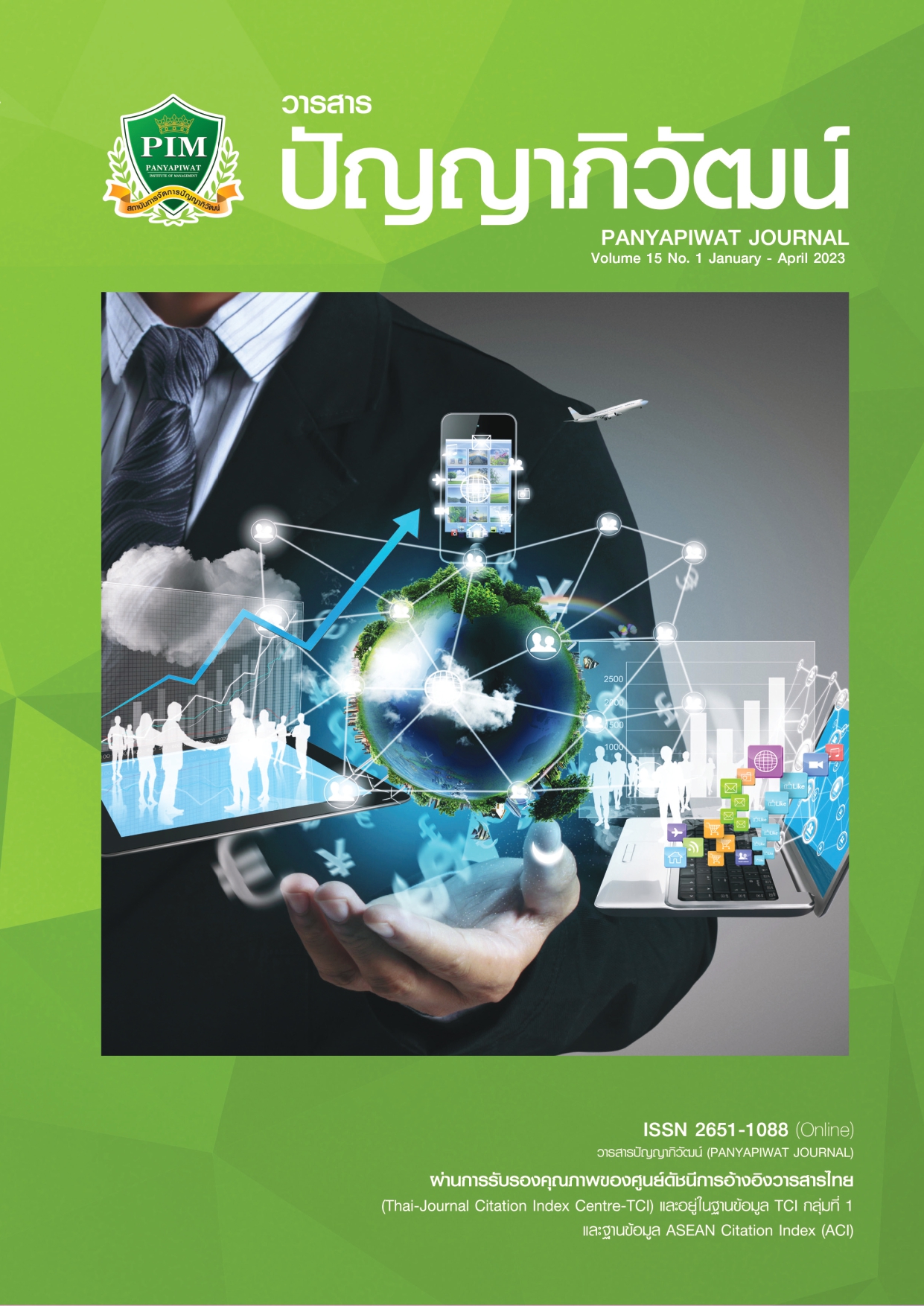การจัดการเรียนรู้ที่บูรณาการเนื้อหาและภาษาเพื่อส่งเสริมทักษะ การอ่านจับใจความภาษาอังกฤษในบริบทป๊อปคัลเจอร์ของนักเรียนระดับมัธยมศึกษา
Main Article Content
บทคัดย่อ
ปัจจุบันปัจจัยสำคัญที่ส่งผลต่อการจัดการเรียนรู้ภาษาอังกฤษให้มีประสิทธิภาพสูงสุดคือ การวางแผน การจัดการเรียนรู้ การเลือกกิจกรรมประกอบการจัดการเรียนรู้ รวมไปถึงการเลือกสื่อการเรียนรู้ที่เหมาะสม และสอดคล้องกับผู้เรียน ซึ่งแน่นอนว่าต้องอาศัยทั้งแนวคิดและกลวิธีที่จะช่วยสร้างความคิดที่เป็นระบบแก่ ผู้สอน ทั้งยังเป็นการพัฒนามโนทัศน์เกี่ยวกับการจัดการเรียนรู้ภาษาอังกฤษอีกด้วย บทความวิชาการฉบับนี้ จึงมีวัตถุประสงค์เพื่อ 1) นำเสนอแนวคิดการเรียนรู้ที่บูรณาการเนื้อหาและภาษา (Content and Language Integrated Learning: CLIL) ที่ได้จากการสังเคราะห์ และ 2) นำแนวคิด CLIL มาใช้ในการจัดการเรียนรู้ที่บูรณาการเนื้อหาและภาษาเพื่อส่งเสริมทักษะการอ่านจับใจความภาษาอังกฤษในบริบทป๊อปคัลเจอร์ของนักเรียนระดับมัธยมศึกษา จากการศึกษาแนวคิด CLIL พบว่า แนวคิด CLIL เป็นแนวการสอนที่มุ่งเน้นสองทางอันได้แก่ ความรู้ทางภาษาและความรู้ทางเนื้อหาวิชา โดยยึดตามกรอบแนวคิด 4Cs (The 4Cs Framework) ซึ่งประกอบไปด้วยหลักการพื้นฐาน 4 ประการ อันได้แก่ เนื้อหา (Content) การคิด (Cognition) การสื่อสาร (Communication) และวัฒนธรรม (Culture) โดยการนำแนวคิด CLIL มาจัดการเรียนรู้ภาษาอังกฤษนั้นเป็นการเพิ่มทักษะการอ่านจับใจความภาษาอังกฤษ ทั้งยังช่วยให้ผู้เรียนพัฒนาด้านเนื้อหาทางวิชาการ รวมถึงเป็นการเรียนภาษาอังกฤษที่ช่วยส่งเสริมทักษะการคิดอย่างมีวิจารณญาณและทักษะการแก้ไขปัญหา นอกจากที่ผู้เรียนจะได้รับความรู้ ความเข้าใจเกี่ยวกับการอ่านจับใจความภาษาอังกฤษแล้ว ผู้เรียนยังได้ตระหนักรู้เกี่ยวกับ วัฒนธรรมและความเข้าใจความแตกต่างระหว่างวัฒนธรรมที่สอดแทรกในเนื้อหาร่วมด้วย
Article Details

อนุญาตภายใต้เงื่อนไข Creative Commons Attribution-NonCommercial-NoDerivatives 4.0 International License.
“ข้าพเจ้าและผู้เขียนร่วม (ถ้ามี) ขอรับรองว่า บทความที่เสนอมานี้ยังไม่เคยได้รับการตีพิมพ์และไม่ได้อยู่ระหว่างกระบวนการพิจารณาลงตีพิมพ์ในวารสารหรือแหล่งเผยแพร่อื่นใด ข้าพเจ้าและผู้เขียนร่วมยอมรับหลักเกณฑ์การพิจารณาต้นฉบับ ทั้งยินยอมให้กองบรรณาธิการมีสิทธิ์พิจารณาและตรวจแก้ต้นฉบับได้ตามที่เห็นสมควร พร้อมนี้ขอมอบลิขสิทธิ์บทความที่ได้รับการตีพิมพ์ให้แก่สถาบันการจัดการปัญญาภิวัฒน์หากมีการฟ้องร้องเรื่องการละเมิดลิขสิทธิ์เกี่ยวกับภาพ กราฟ ข้อความส่วนใดส่วนหนึ่งและ/หรือข้อคิดเห็นที่ปรากฏในบทความข้าพเจ้าและผู้เขียนร่วมยินยอมรับผิดชอบแต่เพียงฝ่ายเดียว”
เอกสารอ้างอิง
Anderson, L. W., & Krathwohl, D. R. (2001). A taxonomy for learning, teaching, and assessing: A revision of bloom’s taxonomy of educational objectives. Longman.
Bloom, B. S. (1956). Taxonomy of educational objectives: The classification of educational goals. Longmans, Green.
Coyle, D. (2000). Meeting the challenge: The 3cs curriculum. Multilingual Matters Ltd.
Coyle, D. (2002). From little acorns. Brussels University Press.
Coyle, D., Holmes, B., & King, L. (2009). Towards an Integrated Curriculum-CLIL national statement and guidelines. The Languages Company.
Coyle, D., Hood, P., & Marsh, D. (2010). CLIL content and language integrated learning. Cambridge University Press.
Dalton-Puffer, C. (2007). Discourse in “Content and Language Integrated Learning” (CLIL) classrooms. John Benjamins.
Doake, D. B. (1974). Comprehension and teaching strategies. 800 Barksdale Road.
Meyer, U. (2007). In the name of identity: Teaching cultural awareness in the intercultural classroom. In Conference on Changing Identities in a Globalized World. Faculty of Communication, Vilnius University.
Mohan, B. A. (1986). Language and content. Addison-Wesley.
Nunan, D. (1990). Second language teacher education. Cambridge University Press.
Núñez, A. (2010). The teaching of English within the theory-Practice alternance model. In Innovación Y competitividad: Memorias de la jornada de investigación 2010 (p. 37). Uniempresarial.
Pru, L. (2019). Characteristics of globalization with a link to education. The classroom. https://www.theclassroom.com/characteristics-globalization-education-8468888.html
Snow, M. A., Met, M., & Genesee, F. (1989). A conceptual framework for the integration of language and content in second/foreign language instruction. TESOL Quarterly, 23(2), 201-217.
Szeman, I., & O’Brien, S. (2017). Popular culture: A user’s guide. Nelson Education Ltd.
Tomlinson, B. (2012). Materials development for language learning and teaching. Continuum Press.
Van Lier, L. (1996). Interaction in the language curriculum: Awareness, autonomy, and authenticity. Longman.


